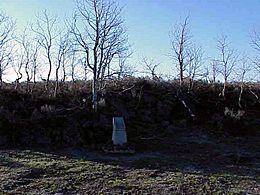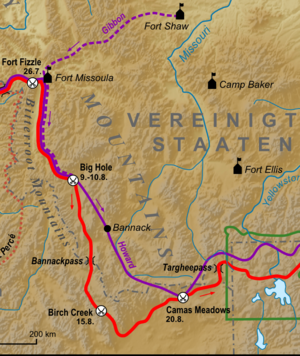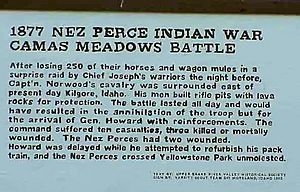Battle of Camas Creek facts for kids
Quick facts for kids Battle of Camas Creek |
|||||||
|---|---|---|---|---|---|---|---|
| Part of the Nez Perce War | |||||||
 Camas Meadows, 2003 |
|||||||
|
|||||||
| Belligerents | |||||||
| United States Army | Nez Perce | ||||||
| Commanders and leaders | |||||||
| General Oliver Howard Capt. Randolph Norwood |
Chief Joseph Looking Glass White Bird Ollokot Toohoolhoolzote |
||||||
| Strength | |||||||
| 300 men | <200 warriors | ||||||
| Casualties and losses | |||||||
| 3 killed 6 wounded |
probably only 2 wounded | ||||||
The Battle of Camas Creek happened on August 20, 1877. It was a surprise attack by the Nez Perce people on a United States Army camp in Idaho Territory. This event was part of the Nez Perce War. The Nez Perce successfully fought off three companies of U.S. cavalry. They continued their journey to escape the army.
Contents
Why the Battle Happened
The Nez Perce Journey
After a tough fight at the Battle of the Big Hole in early August, the Nez Perce moved south. They traveled through Montana Territory and then into Idaho. Their goal was to reach the Great Plains in Montana. They took a longer, less known path to confuse the U.S. Army that was chasing them. A guide named Poker Joe helped lead their march. White settlers in the Lemhi River valley had been warned about the Nez Perce. Most of them left their homes and went to the town of Lemhi.
General Howard's Pursuit
General Oliver O. Howard was leading the U.S. Army forces. He did not follow the Nez Perce directly. Instead, he took a shorter path to the east. He hoped to cut them off near Yellowstone National Park. General Howard had about 310 soldiers. He also had civilian helpers and Native American scouts. Most of his scouts were Bannocks, but some were Nez Perce who were friendly to the U.S. Army.
Howard sent 50 men ahead to guard Red Rock Pass. He wanted to trap the Nez Perce between his main force and these soldiers. General Howard was being criticized because he had not defeated the Nez Perce yet. The war had already lasted two months. After their losses at the Big Hole battle, the Nez Perce group had about 700 people. Fewer than 200 of them were warriors.
Events at Birch Creek
The Nez Perce had lost many women and children at the Big Hole Battle. This made their young warriors want revenge. Their leaders found it hard to control them.
- On August 12, the Nez Perce killed five ranchers in Montana.
- On August 13, they crossed into Idaho. They met White settlers at Junction. Nez Perce leaders Looking Glass and White Bird spoke with the settlers. They said they were friendly.
- Two days later, the Nez Perce met a group of eight wagons and eight men at Birch Creek. At first, they were friendly. However, after the Nez Perce asked for and were given whiskey, the situation became dangerous. Five of the White men were killed. One White man escaped, and two Chinese men were set free. One Nez Perce warrior also died. The Nez Perce leaders then poured out the rest of the whiskey. They also burned the wagons.
The Race to Camas Meadows
From Birch Creek, the Nez Perce turned east toward Henrys Lake. General Howard's path was to their north in Montana. Howard planned to cross into Idaho at Monida Pass. He wanted to stop the Nez Perce at Camas Creek, near Dubois.
On August 17, 39 volunteers from Virginia City joined Howard's cavalry. Captain Randolph Norwood also joined Howard with 50 fresh cavalry men. Howard pushed his troops hard to catch the Nez Perce near Camas Creek. But he was a day too late.
Bannock Indian scouts, who were ahead of Howard's cavalry, saw the Nez Perce. They saw the Nez Perce rear guard cross the road toward Camas Meadows. One of Howard's scouts, Chief Buffalo Horn, even saw their camp.
On August 18, the Nez Perce camped at Camas Meadows. This was about 15 miles (24 km) east of Howard. Their camp was in a meadow with Spring and Camas creeks flowing through it. The Nez Perce called their camp Kamisnim Takin, which means "camas meadows." Howard marched to Camas Meadows on August 19. The Nez Perce had already left that day, continuing east. Howard set up his camp there that night. He called it Camp Callaway. He made sure to place guards all around the camp.
The Surprise Raid
The Nez Perce scouts saw how carefully General Howard had set up his camp. They reported this to their chiefs. The chiefs decided to launch a raid. Their goal was to take the soldiers' horses and mules. This would make it harder for Howard's cavalry to chase them. The exact number of raiders is not known, but it was at least 28. The chiefs did not plan a big battle.
Yellow Wolf, a Nez Perce warrior, described the raid:
We traveled slowly. No talking loud, no smoking. The match must not be seen. We went a good distance and then divided into two parties - one on each side of the creek... Before reaching the soldier camp, all stopped, and the leaders held council. How make the attack? The older men did this planning. Some wanted to leave the horses and enter the camp on foot. Chief Looking Glass and others thought the horses must not be left out. This last plan was chosen - to go mounted. Chief Joseph was not along.
Around 4:00 a.m., some Nez Perce got off their horses. They quietly moved among the tied-up horses to cut them free. Then, two things happened at the same time. As the mounted Nez Perce approached the camp, a guard shouted, "Who goes there?" At the same moment, a scout accidentally fired his gun inside the camp. This caused an alarm from two places before many horses were set free.
However, about 200 mules were freed. The Nez Perce focused on making them run north. This allowed the raiders to control the loose animals. Despite all the noise, some soldiers thought they heard the loud voice of Looking Glass giving orders. Bullets flew around, hitting some wagons. Only one soldier was hit, and his injury was minor. The darkness, noise, and surprise caused a lot of confusion. But the cavalry officers and men quickly got dressed and ready.
General Howard ordered a strong group to chase the raiders and get the animals back. Within minutes, three cavalry companies were ready. By dawn, nearly 150 horsemen were galloping north. They were chasing the raiders, who had a head start of several miles. Besides the mules, about 20 horses belonging to the Virginia City volunteers were also missing. The volunteers were later paid for their lost horses.
A newspaper reporter wrote about the raid:
Oh, I am one of the volunteers, who marched right home on the tramp, tramp,
When Joseph set the boys afoot, at the battle of Callaway's camp.
The Battle of Camas Meadows
Major Sanford led the cavalry companies of Captains Carr, Jackson, and Norwood. This group of about 150 men set off at dawn. They were chasing the Nez Perce and the stolen mules. The Nez Perce rear guard saw them coming. They set up a surprise attack about 8 miles (13 km) north of Camp Callaway.
Some Nez Perce warriors continued to drive the mules to their camp. Others hid among black lava hills and broken land with aspen trees and sagebrush. A few Nez Perce spread out in a line in a grassy meadow. This meadow was about half a mile (0.8 km) wide. It was bordered by a lava ridge about 18 feet (5.5 m) high and 500 to 600 feet (150 to 180 m) long.
Sanford and his three companies took positions behind the ridge. They got off their horses to fire at the Nez Perce from a distance. The distance between the two sides was too far for accurate shooting. But when a shot hit Lt. Benson in the hip, the soldiers realized something. The Nez Perce in the meadow were acting as a trick. Other Nez Perce had been quietly moving forward on both sides to attack the troops from the flanks.
So, Sanford ordered a bugler to signal a retreat. The cavalrymen's horses had been moved to the back, so their retreat was confusing. However, Captain Randolph Norwood and 50 men did not immediately obey the order to retreat. Instead, they slowly moved back to a strong position. The Nez Perce surrounded them there, forcing them to stop and fight. The other two companies had left them. For the next two to four hours, the two sides fired at each other.
Meanwhile, General Howard received a message that the cavalry companies were in trouble. He left Camp Callaway with more soldiers. He found the two retreating cavalry companies. Captain Sanford said he did not know where Captain Norwood was or what had happened to him. Howard pushed forward. In the middle of the afternoon, he found Norwood and his men. They were hiding in their rifle pits made of lava rock. These pits were along the tops and edges of ridges. They protected an area for their horses. The Nez Perce then disappeared, and the battle ended.
Norwood's group had one man dead. Two men were badly wounded and later died. Six to nine others were wounded. Yellow Wolf said that "no Indian was badly hurt, only one or two just grazed by bullets." Wottolen was wounded in his side, and Tholekt's head was grazed.
What Happened Next
The Nez Perce were a bit disappointed. Most of what they stole were mules, not horses. But losing the mules made it much harder for Howard's army to move quickly. General Howard had failed to defeat the Nez Perce many times. After this battle, he did not chase them very hard. One journalist thought this was a good thing. He wrote, "I honestly think Joseph could beat our cavalry and cannot blame General Howard for not fighting him."
The evening after the battle, Howard received 280 more soldiers. Two days later, on August 22, 50 Bannock scouts joined the camp. They were "gorgeous warriors," with dyed hair and decorations. They had been promised all the Nez Perce horses they could capture. A skilled White scout, Stanton G. Fisher, and the Bannocks scouted ahead. Howard followed slowly. He was so slow that Buffalo Horn and many Bannocks left the army in frustration and went home. Fisher said, "Uncle Sam's boys are too slow for this business."
Howard learned that the Nez Perce had entered the wild area of Yellowstone National Park. He stopped his chase and rested for several days at Henrys Lake. Howard's troops were tired. They had marched for 26 days, covering about 20 miles (32 km) each day. The Nez Perce, even with wounded people, women, children, and elders, had moved faster and further. A journalist noted that they had a "talent for stealing fresh horses from the settlers."
Meanwhile, General Philip Sheridan, Howard's boss, was gathering more than a thousand experienced soldiers and Native American scouts. They planned to defeat the Nez Perce when they came out of Yellowstone.
About the Battle Sites
The places where Howard's camp was, and where the fight happened, are now special historical sites. They were named a National Historic Landmark in 1989. They are part of the Nez Perce National Historical Park and the Nez Perce National Historic Trail. The sites are mostly untouched. There is a grave marker at the camp site. You can still see the rifle pits dug by Captain Norwood's men at the battle location.




